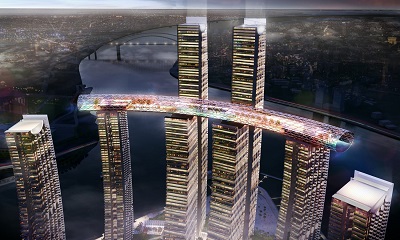 Friday, April 19, 2024
Friday, April 19, 2024  Friday, April 19, 2024
Friday, April 19, 2024 
An army of 6,000 construction workers is hard at work at a large site overlooking the conflux of the Yangtze and Jialing rivers in the south-western Chinese megacity of Chongqing. Eight skyscrapers are rising from the river banks: two above 350m and six above 250m.
Raffles City Chongqing, a project headed by the architect Moshe Safdie, will boast 134,000 sq m of homes, shops, offices, entertainment, transportation links and a public park. It also features a more unusual claim to fame: a “horizontal skyscraper” 300m in length, stretching across four of the main towers at the 42nd floor. With the building situated in an earthquake zone, it “floats” on top of the towers to create the necessary sway.
No landmark development in China is complete without a world record, and Raffles City Chongqing has the highest skybridge linking the most towers. With an adjacent pair of towers connected by smaller skybridges, workers and residents can move around the eight-tower development without needing to return to ground level.
Click here to sign-up and receive the Weekly Round Up in your inbox every Saturday
“It’s going to become like the heartbeat of the city,” says Safdie of what he describes as his most complex project to date. “In these dense cities like Chongqing there’s no room for big public parks [on the ground], so we have to lift them into the sky.”
Chongqing is certainly dense. Outside the building site, the streets are crowded with markets and wholesalers, hawkers and food stalls. Construction workers huddle over bowls of spicy noodles, vendors carry heaving baskets of fruit on their shoulders and shoppers barter over prices.
Safdie says the development reflects a growing trend in urban planning: having developed vertically, skyscraper cities are starting to spread horizontally.

Share YOUR News and Brand YOUR Business – Click here to order the media kit